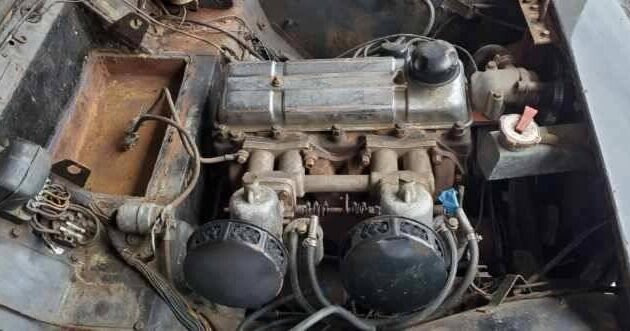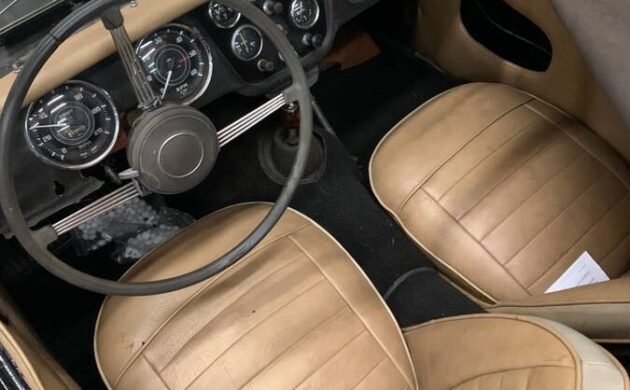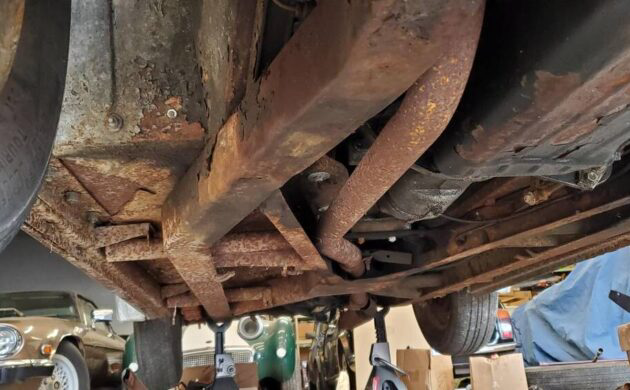Standard-Triumph never delineated between a TR3A and a TR3B – those are designations that enthusiasts have adopted to differentiate which TR3 configuration you’re discussing. The first TR3 followed the demise of the slower TR2 in 1955. It was simply called the TR3. It had a narrow grille and was a true roadster with snap-on weather equipment, including side curtains. Brisk sales encouraged an update in 1957, when the car was given a grille that extended nearly the entire width of the front of the car, external door handles, and a lock for the boot lid. This car shared the same 1991 cc inline four-cylinder tractor motor – no kidding, a version of this motor was used in Ferguson tractors – that propelled the original TR3. Owners called this version the TR3A. Here on craigslist, is a TR3A for sale at $11,900, located in Knoxville, Tennessee. We owe Gunter Kramer for this tip!
The motor is a Standard-Triumph wet-liner type four-cylinder, 1991 cc’s, paired with twin SU carburetors making between 95 and 100 bhp. The factory transmission is a four-speed manual; optional overdrive was offered. Thanks to front disc brakes, this nimble little roadster was popular for autocross, rallies, and track days. A TR3A works rally car met with some success in major international events including the Monte Carlo Rally. Our subject car has a dusty engine bay with the usual rusty battery box. The listing is brief but does make the suggestion, “clean the fuel system and drive it as is.” No mention if the motor turns or when it last ran.
The interior is quite good given the apparently non-running condition. That cracked steering wheel is not too difficult to repair. All the gauges are present, though the speedometer appears to be reading about 30 mph while the car is shut off. The seat surfaces would be vinyl. Other photos show the tonneau cover and top bows on the car, but there’s no photo of the top erected.
The undercarriage is no worse than any other that I’ve seen on a car that’s been sitting a while. Surface rust can be sanded and treated. This seller provides several shots of the underside of this car – they all look about the same, with no rust holes apparent. A few dents are going to need attention, but the chrome and the grille look reasonably straight. I like a disc wheeled car; wires are a pain to maintain. This one is a long way from a show car, but if it could be made to run and drive without too much trouble, the price is very tempting.






Could be a good buy but to get to the frame areas that are going to have the most rust the body is going to have to come off. Body off isn’t that difficult and if the frame hasn’t been compromised it would be worth it to get a nice car in the end.
I wish the author would avoid the lazy cliche myth about the “tractor engine”. Standard developed the 2 litre wet-sleeve engine for use in the Standard Vanguard road car. It was then also used modified versions in the TR2, TR3 and TR4 and sold in smaller numbers to Massey Ferguson who did install it in their tractors.
To say the TR3 had a “tractor engine” is like saying that the Ford Mustang had a “boat engine” just because the small-blocks V8 was also modified for marine use.
These are easy to work on and a good candidate for an amateur restoration. Parts are available and not too costly.
Back in the day I had a 1959 with the tractor engine letting me down with a cracked fly wheel and the usual Lucas Prince of darkness problems. Despite all that, I loved it but was talked into selling it by my new-found gorgeous southern belle wife. Turned out she was far more of a pain than ANY car could ever be. Dumping her was a joy, dumping the TR3 was the opposite, despite its occassional problems. When it ran, which was mostly all the time, it was an absolute gas to maneuvre along the roads of northern California wine country.
Prince of Darkness reminds me of my 59 Triumph Tiger motorcycle with the never ending electrical problems.
Had brg one in 1959 in LA. Drove it across country to the midwest in Jan of 1963. Right leg was roasted, left leg was frozen. Never spent any money on it other than maintenance. Great, fun car
Time to retire the tractor engine and Prince of Darkness as the hackneyed and trite expressions they are.
The problem was in the plastic assembly materials, usually. I guess nobody ever had a Ford, Chevy or Chrysler have a rotor burn through? Yeah, right.
I used the ¨tractor engine¨ label as a joke, no more. The engine in and by itself was super. As far as the ¨Prince of Darkness¨ label goes, it was the justified reaction of people who had been abused by it. Today even Lucas seems to be ok, after Bosch bought them and apparently cleaned house.
Gerard is more than right. I have owner my “3” since ’67and drove it during college time. I starts right up and run perfectly every summer. I have replaced the harness once and rebuilt the generator and starter once. It sits next to a 356 in my garage and it gets all of the attention to visitors (other than Porsche people). If I were to begin again in this hobby it would be with the TR 3.
Rather large bolted in patch in passenger side forward floor, covering a substantial hole. Can’t judge the inner sills from the photos provided, except for the angle iron welded on to accept the bolts for the patch. A thorough under-side inspection would be in order. Also seeing some nut and bolt fastening for the transmission tunnel, meaning that the “nut-in-cage” fasteners have gone away. Commission number makes this about 13000 older than mine, a 1959 model manufactured in late October 1958. If you look closely, this one appears to have the “Brooklands” screen mounting bolts in the scuttle, which were done away with for the 1959 model year. Almost $11K seems a tad ambitious. Its “running” status is suspect, too, as there is no fuel line to the carbs. No mention of side curtains, not cheap to find. I speak from the familiarity gained over the protracted (27 year) restoration of mine (finished in 2007) where the only fasteners not removed were the bolts holding in the pedal box blanking plate for right-hand drive versions. My current Herald and Sprite projects are looking like they may not be finished a lot sooner, but I should speed them up as I’m 77 years old and time to work on them comes in shorter bursts during the day. Jus’ sayin’.
Tractor engine or not, I buy a lot of parts for my Midget 1500 from a tractor supply store rather than MOSS. I love MOSS and they have helped me out many times, but they are mail order and living in rural Midwestern Ontario I can get parts for the engine next day or right off the shelf and they are generally pretty inexpensive if you factor in duty, shipping and conversion from the Canadian Peso int IS dollars.
Most of the time, a non working light is a grounding issue, and moreover, the continuity of the bonding.
matt – could that be the case with my wife´s ¨93 Ford Explorer? The vehicle is super on every level, but on occassion, it acts as if the battery were bad, all electric action comes to a halt. After jump starting, the car runs great. The battery is only a year old. Thanks for yiur input in advance, GF.
What a great car. It does have a tendency to head off road into farm fields occasionally. Maybe that’s why I see more MGA’s of that vintage around than TR3s.
After a morning cruise through the country side you can stop in at the Pub for some cold toast and warm beer.
Just kidding, just a beautiful piece of British automotive history here.
Sadly, except for a few hold outs like this, those days are gone, and will never come again.